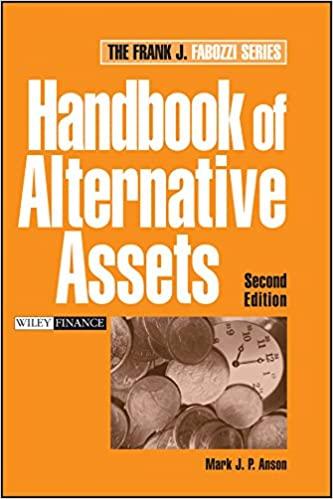Question
After a dismal period of financial losses, Expand Ltd has started to report better results, with annual revenues of around $240m and net operating expenses
After a dismal period of financial losses, Expand Ltd has started to report better results, with annual revenues of around $240m and net operating expenses $132m (including depreciation $22m). Annual debt financing expenses are $36m on 6% interest-only debt contracts. The CFO has completed a market value balance sheet for the CEO and Board of Directors:
| EXPAND LTD MARKET VALUE BALANCE SHEET: | |
| ASSETS | EQUITY AND LIABILITIES |
| CASH $60m | Paid-up share capital $300m |
| Inventories $100m | |
| Factory, land and equip $650m | Lond term 6% debt $600 |
| Vacant Land $90m | |
| Total $900m | Total $900m |
The company is considering an investment into an additional product line. Proto-type machinery and products were developed over the last few months at a cost of $4m. For full-scale production, new machinery would need to be purchased, located and commissioned. The new product line is a one-off opportunity and the machinery is expected to last for five years.
The company uses accrual accounting methods but some cash flow data is also available. The new product line is expected to offer annual revenues of $60m, with annual cost of goods sold and other operating expenses of $18m, excluding maintenance and depreciation expenses. As the machinery gets older, maintenance costs are expected to increase at a rate of $200,000 p.a. for the following three years (from the initial $2m at the end of the first year). In addition, one-fifth of the existing $30m of service department costs will be assigned to the new product lines overhead costs. Sales terms are presently strictly cash only. In order to promote the new products, sales terms for the new products will be relaxed such that settlement is allowed up to three months after sale. Notwithstanding the companys acceptance of this sales marketing strategy, the marketing manager estimates that the new product range will compete with some of the companys current products and so reduce existing sales volumes by 10%.
The company uses accrual accounting methods but some cash flow data is also available. The new product line is expected to offer annual revenues of $60m, with annual cost of goods sold and other operating expenses of $18m, excluding maintenance and depreciation expenses. As the machinery gets older, maintenance costs are expected to increase at a rate of $200,000 p.a. for the following three years (from the initial $2m at the end of the first year). In addition, one-fifth of the existing $30m of service department costs will be assigned to the new product lines overhead costs. Sales terms are presently strictly cash only. In order to promote the new products, sales terms for the new products will be relaxed such that settlement is allowed up to three months after sale. Notwithstanding the companys acceptance of this sales marketing strategy, the marketing manager estimates that the new product range will compete with some of the companys current products and so reduce existing sales volumes by 10%.
The company will use existing vacant land to locate the new factory. The land was purchased three years ago for $70m. Also, some of the existing cash balance will be used to buy $15m of raw material stock to commence production. This stock will be used up each year (becoming part of the finished goods that are sold each year and so are part of cost of goods sold expense at the end of each year). A fresh amount of raw material stock will be purchased at the start of each period. The remainder of the project will be funded through a 6% mortgage loan from a merchant bank. As a result of the expected profitability of the project, shareholder dividends are expected to increase by $20m p.a.
The new factory and European-engineered machinery will together cost $145m, payable at the beginning of the first year. Expand Ltd has an existing $5m fixed contract with an engineering firm to help commission all equipment acquisitions. For accounting purposes, $1m of this amount will be allocated against the new machinery. The machinery depreciation rate p.a. is the same for accounting and tax purposes: 20% of initial cost. After five years, the new factory and machinery will be demolished and cleared (with a $10m scrap value). The cleared land is expected to be worth $160m at that future date.
Unless otherwise specified, assume all cash flows occur annually at year-end and assume operating expenses are variable. The company tax rate is 30% but no tax bill is likely because prior accumulated losses exceed expected new annual profits over the life of the project.
If the relevant required rate of return is 12% per annum, evaluate the acceptability of the new project using the NPV method.
Step by Step Solution
There are 3 Steps involved in it
Step: 1

Get Instant Access to Expert-Tailored Solutions
See step-by-step solutions with expert insights and AI powered tools for academic success
Step: 2

Step: 3

Ace Your Homework with AI
Get the answers you need in no time with our AI-driven, step-by-step assistance
Get Started


